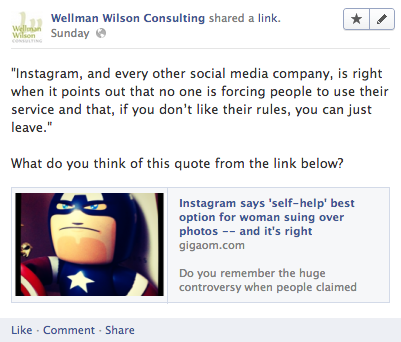 I go to a lot of networking events and hand out my business card on a regular basis. I talk to a lot of business owners and end up meeting quite a few who offer services that I am (potentially) going to be interested in. I always try to have a little more conversation with business owners that I might call for help one day. I like to get to know more about who they are and how they work. It gives me greater comfort when the day comes that I make the call to ask for help. It also helps me remember their name and what they do.
I go to a lot of networking events and hand out my business card on a regular basis. I talk to a lot of business owners and end up meeting quite a few who offer services that I am (potentially) going to be interested in. I always try to have a little more conversation with business owners that I might call for help one day. I like to get to know more about who they are and how they work. It gives me greater comfort when the day comes that I make the call to ask for help. It also helps me remember their name and what they do.
Apart from giving out my card, I take a lot of cards as well. The give and take is usually reciprocal. If you’ve ever been to a networking event, you know how it goes.
In the aftermath of almost every networking event, I inevitably start receiving newsletters that I have not personally subscribed to or given my permission to add my email to the list.
This bothers me.
Not because I don’t want the newsletters (sometimes I do).
It bothers me because it’s not the best way to grow an engaged email list. In fact, in just a few months, this tactic could put some of those very business owners I was thinking of doing business with in the position of breaking the law in Canada.
Canada’s new legislation - in effect July 1, 2014
Canada’s Anti-Spam Legislation has been in the works for years. While it’s long overdue and has its challenges, some of the basic principles of consent have long been considered best practices for “commercial electronic messages” (a.k.a. email marketing). The CASL’s information page about commercial electronic messages states:
Generally, the sender will need to obtain consent from the recipient before sending the message and will need to include information that identifies the sender and enables the recipient to withdraw consent.
Three requirements:
Make sure you have permission to add someone to your list.
An opt-in form on your website is one way to gain consent. If you want to subscribe everyone you meet at an event, ask first. We actually use a double opt-in to protect our subscribers from having their email added by someone else. This means that if you subscribe to our newsletter (a very good idea, by the way), you will receive an email asking you to confirm your subscription. We don’t do this to annoy you. We do it to make sure you’re only subscribed if you truly want to be. Without the email confirmation, anyone could enter your address and subscribe you. We wouldn’t know you hadn’t consented, but you sure would.
Identify who you are when you send an email.
We have a statement in every email that goes out to our newsletter list - it tells the recipient why they’re subscribed to our email list. I have gotten emails from businesses that had me scratching my head - why am I getting this? I look through and if they don’t have a statement like this to remind me, I will probably hit unsubscribe. (I might anyway if I haven’t given permission.)
Make sure there is a clear, easy way to unsubscribe.
The phrase this information page uses is “withdraw consent”. I like that phrase. It describes perfectly what that action is. Unsubscribes are telling you they don’t consent to receive content anymore. It doesn’t mean the person isn’t interested. It doesn’t mean they won’t come back. But that decision must be respected. Ultimately, it improves the quality of your email list if the people who are subscribed truly want to see your content. I do a mass unsubscribe every 12-18 months to start fresh and declutter my inbox. I often resubscribe to the lists that deliver value in areas I need.
It was best practice long before it was law
Seth Godin coined the phrase Permission Marketing (affiliate) in his book in 1999. If you haven’t read the book, you can get an idea of the permission marketing philosophy from Seth’s Blog. Asking permission requires patience and level-headed focus on the end goal. Getting distracted by vanity metrics such as newsletter subscriber counts leads to practices like adding every person you meet to your list whether it’s relevant for them or not. Wouldn’t you rather have 100 relevant subscribers with a 50% open rate than 5,000 with a 1% open rate?
What’s that one easy step?
Get permission.
Don’t assume you have it; know you do. I guarantee your email marketing will go much better with a list of people who have invited you into their inbox.







